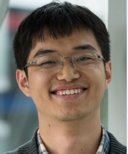 This thesis covers mainly the broad topic of Taylor-Couette (TC) and Rayleigh-Bénard (RB) turbulence, with wall roughness. The roughness elements vary in shape, size, sparseness, and alignment.
This thesis covers mainly the broad topic of Taylor-Couette (TC) and Rayleigh-Bénard (RB) turbulence, with wall roughness. The roughness elements vary in shape, size, sparseness, and alignment.
‘Turbulence is everywhere, and no wall surface is a hundred percent smooth,’ Xiaojue Zhu describes the general relevance of his PhD work. ‘We studied turbulence with wall roughness by means of direct numerical simulations. The approach becomes more and more feasible with the increasing power of supercomputers all over the world.’
The most prominent advantage of direct numerical simulation, is that one can get every detail of the flow information, so unravelling the physics behind the theoretical equations, especially when thousands of parallel cores can be used. ‘We learnt about phenomena by seeking the extremes of the parameters,’ Xiaojue says.
In his PhD work, a huge span of parameter space was covered, thus far unprecedented. And a vast amount of different kinds of surface roughness. ‘The code we used to simulate turbulence, is called AFiD,’ Xiaojue says. ‘It is an in-house developed code and it is highly parallelized and efficient. We combined it with an immersed boundary method, to track the roughness surfaces.’
In the beginning of the PhD project, turbulence with grooved wall roughness, parallel to the flow direction, was studied.
‘After that, we tried square bars perpendicular to the flow direction,’ Xiaojue says. ’By varying roughness heights - and later, its symmetry - we showed that one can tune transport properties, such as heat transfer, which might imply some important practical applications one day.’
In the last chapter, the immersed boundary method was further extended, to study the interaction of multiple surface nanobubbles.
Academics
‘Simulation techniques play an ever increasing role in modern physics,’ Xiaojue says. ‘Here, we can go deeper than the experiments on the details of the flows. With the information we collect from simulations we can further guide experiments. In fact, in most cases, experiments and numerical simulations are complementary to each other.’
Regarding his future job, Xiaojue prefers a career in academics, because he enjoys academic research as well as the contact and communication with colleagues and students, working towards a commonly shared goal, to produce new knowledge.
‘During the PhD, I learnt a tremendous number of technical skills, spanning from the micro/nano-world to the macro world,’ he says. ‘My research is mainly curiosity driven. Nevertheless, all the topics are very important scientific frontiers, and may have huge applications in various fields.’
Rayleigh-Bénard convection serves as an example. ‘Although what we are doing at the moment is fundamental, it is the simplest model for convection that happens in geophysics and astrophysics,’ Xiaojue says. ‘I’m planning to apply for a post-doc position in Europe or US, where I can gain more connection to interdisciplinary research.’
Educational skills
Xiaojue is looking forward to tell people what he learnt during his Mesa+ PhD project. ‘These skills are helpful in various areas of research,’ he says. ‘I learnt to explain my work in an attractive, educational kind of way: not by simply transferring knowledge - such as the exact equations involved - but by talking from my personal perspective about the physics behind the equations.’
Publications
Within Mesa+, Xiaojue enjoyed the good seminars. ‘Especially the ones concerning Soft Matter,’ he says. ‘I added this area of research to my interest fields, and developed myself in this direction more.’
Xiaojue published his findings in important physics and fluid mechanics journals such as: Nature Physics, Physical Review Letters, Journal of Fluid Mechanics, and Soft Matter.
